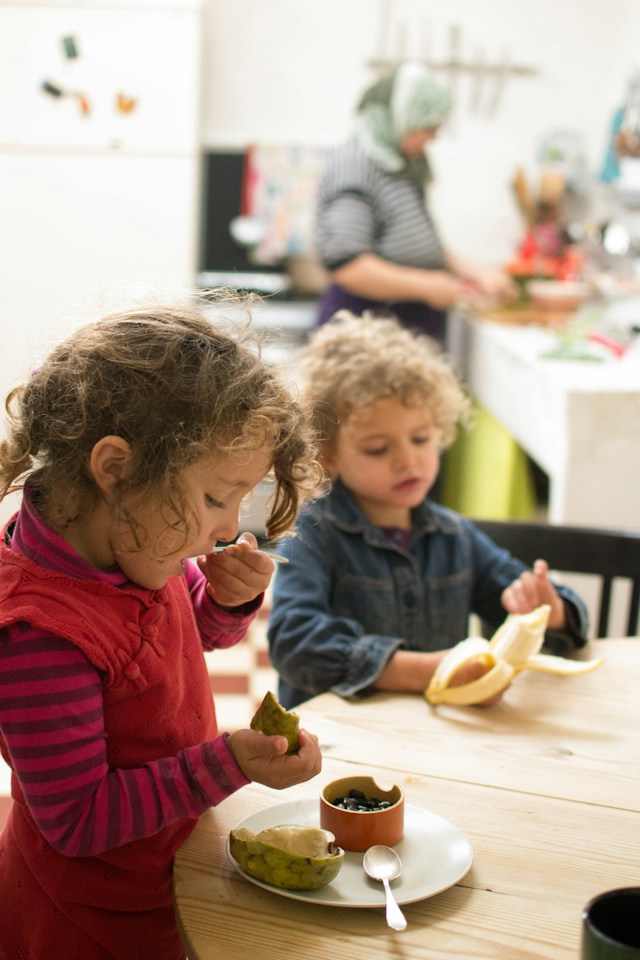This post may contain affiliate links. If you shop from one of our links, we may earn a commission.
There is something special about gathering around a table and sharing a meal with loved ones. It not only fills our stomachs but also our hearts and souls. And what better way to do that than by serving family-style meals? The benefits of serving meals in this manner go beyond just satisfying our hunger. It brings families and friends closer together, fosters a sense of community, and promotes healthier eating habits. In this blog post, we’ll explore the many reasons why you should consider incorporating family-style meals into your dining routine.
Understanding Family-Style Meals: A Quick Overview
Family-style meals have been popular for a few decades now and for good reason. But what exactly is family style dining? In simple terms, it refers to a type of meal service where the food is served in serving dishes placed in the middle of the table, and everyone helps themselves to the dishes and passes them around.
If you want to reduce mealtime battles and decrease picky eating, then this feeding style is for you. When kids are given the opportunity to serve themselves as much or as little as they want, the mealtime power struggles decrease almost immediately.
Top Reasons to Adopt the Family-Style Meal Approach
Your child’s success at a meal is not determined by how much of the food that they ate, but rather, by how they navigated the meal with their attitude and behavior. Family-style meal service offers a multitude of reasons why you should consider adopting this approach. And yes, even toddlers can participate in serving themselves.

Family-style meals reduce picky eating
First and foremost, it encourages children to try new foods. When they see a variety of dishes on the table, they are more curious and willing to sample different foods. If your child is allowed to choose what foods go onto their plate, their anxiety immediately decreases because the expectation to eat that item is lowered.
Now, I know what you’re thinking. Your child will only put their preferred items on their plate and never try anything new again. Keep in mind, that sitting at the table smelling the food, hearing it sizzle, or observing others eat the item still counts as an exposure in a non-threatening way. When we remove the pressure to try everything, kids actually have decreased anxiety and are more likely to try these foods later on.
Also, kids eat better when a loved one eats WITH them. Rather than serving them the food and leaving them to eat alone, sit down at the table to enjoy the meal times (or snacks) together.
Improves fine motor skills
Serving meals family-style creates a positive dining experience for everyone involved, particularly for little hands. Children have the opportunity to practice their fine motor skills as they serve themselves and pass dishes to others. This not only enhances their independence but also promotes a sense of responsibility and participation during mealtime. Scooping vegetables, using tongs to pick up food, and passing bowls and plates all encourage them to use various muscles and practice hand-eye coordination.
Furthermore, the act of serving their own portions and sharing food can have a positive impact on self-esteem and confidence, especially for children. When children serve themselves and pass dishes to others, they feel a sense of responsibility and contribution. This empowers them and gives them a sense of ownership over their meal.
Keep in mind, this is likely to be a messy process, especially for younger children. But over time they will learn how to navigate this process well. For toddlers, consider putting food in smaller, more manageable serving bowls, plates, or small pitchers.
Promotes healthy eating habits
If you have been following my blog, you already know that I’m not a big fan of diet culture lingo. Teaching our kids that foods are “good” or “bad”, “healthy” or “unhealthy”, only instills feelings of guilt or shame for not eating a certain way.
However, being a good role model at the table is a great way to encourage a balanced diet. Furthermore, serving meals family style promotes a balanced and varied diet. When a variety of food groups are presented in front of us, we are more likely to include a diverse range of nutrients on our plates. This is especially important for children, as it exposes them to different flavors and textures, helping them develop a broader palate and a healthy relationship with food.
Improves social skills
The psychological benefits of sharing food in a family-style setting are abundant and can play an important role in enhancing the dining experience. One of the main benefits is the sense of belonging and connection it fosters. When family members come together around a table and pass dishes to one another, it creates a bond and strengthens relationships. This communal act of sharing food creates a warm and inviting atmosphere that promotes a sense of unity and togetherness.
Sharing food in a family-style setting also encourages a positive attitude and overall well-being. Research shows that sharing a meal with loved ones can increase feelings of happiness and satisfaction. It creates an opportunity for meaningful conversations and laughter, which are essential for mental health and emotional well-being.
Children who are part of families that choose to eat together most days of the week get better grades in school, have decreased depression and anxiety, lower incidence of eating disorders, and decreased substance and alcohol abuse.

Promotes intuitive eating
Intuitive eating is all about listening to your body’s cues and eating in a way that honors your hunger and fullness. It’s a mindful and intuitive approach to nourishing your body without strict diets or rules. When it comes to promoting intuitive eating in a family-style meal setting, there are a few key strategies to keep in mind.
First and foremost, it’s important to create a positive and relaxed atmosphere at the table. Encourage your family members to listen to their bodies and consume enough food until they are satisfied, rather than forcing them to finish everything on their plates. Allow them to choose serving sizes that feel right to them and choose the foods that they truly enjoy. By giving children autonomy over their meal choices, you’re helping them develop a healthy relationship with food and listen to their own hunger and fullness cues.
Additionally, encourage your family members to eat slowly and savor each bite. This allows them to truly enjoy the flavors and textures of the food, while also giving their bodies time to register fullness. Avoid distractions such as screens or rushed mealtimes, and instead focus on the present moment and the joy of sharing a meal together.
Finally, be a positive role model by practicing intuitive eating yourself. Let your children see you listening to your own hunger and fullness cues, and enjoying a wide variety of foods without guilt or restriction. By modeling this behavior, you’re showing them that it’s possible to have a healthy and balanced relationship with food.
Provides flexibility
Another compelling reason to adopt the family style serving approach is the flexibility it offers. With different food items spread across the table, each individual can customize their own plate to suit their taste and dietary needs. This is particularly beneficial if you have a fussy eater or child with dietary restrictions, as they have the freedom to choose what they want to eat without feeling pressured.
Division of Responsibility in Family-Style Meals
When it comes to family-style meals, the division of responsibility is a key factor in creating a positive and healthy eating environment. The concept of division of responsibility, developed by Ellyn Satter, RD, is all about giving each family member a role and responsibility when it comes to mealtime.

As a parent, your responsibility is to decide what foods to serve, when to serve them, and where. You have control over what is on the table and the timing of meals and snacks. It is important to offer a variety of foods and expose kids to different flavors and textures. However, it is crucial to remember that it is the child’s responsibility to decide what and how much to eat.
The division of responsibility allows children to have autonomy and control over their own eating habits. It teaches them to listen to their hunger and fullness cues and make decisions about what foods they want to eat. Giving children the freedom to choose empowers them and helps them develop a healthy relationship with food.
By following the division of responsibility in family-style meals, you are fostering a positive and healthy eating environment. It encourages children to become more independent and responsible for their own eating habits. So next time you gather around the table for a family-style meal, remember to let your child take control of their own plate and watch them grow into confident and intuitive eaters.
You can learn more about the division of responsibility here.
How to Easily Implement Family-Style Meals at Home
If you’re convinced of the benefits of family-style dining and are eager to start incorporating this approach into your dining routine, you may be wondering how to get started. Implementing family-style meals at home is actually quite easy and can be a fun and rewarding experience for the whole family.
Provide kid-safe serving dishes
First, you’ll need a variety of serving dishes and platters that can hold all the different components of your meal. Opt for dishes that are easy to pass around and that your children can comfortably serve themselves from. Additionally, make sure you have enough utensils for everyone to serve themselves without any hiccups. You don’t need to go buy nice, new dishes. Just use what you already have.

Choose Family-Style Meals
When it comes to meal planning, consider dishes that lend themselves well to family-style service. Keep in mind, that family-style serving works with any meal, however, one-pot meals and casseroles are great options as they can easily be placed in the center of the table for everyone to enjoy. You can also include a variety of side dishes and condiments that can be passed around to customize each person’s plate to their liking. This can be particularly helpful for picky eaters.
Encourage participation
To involve your children and make them feel part of the process, encourage them to help with setting the table and arranging the dishes. Let them take ownership of their meal by allowing them to serve themselves and pass dishes to others.
Provide safe foods
It is always a good idea to include 1-2 safe foods at each meal. These can be foods that you know your children enjoy and feel comfortable eating. By having familiar options available, they can choose what they feel comfortable with while also being exposed to new foods.
Place all food on the table
When it comes time to serve the meal, place the food in serving dishes at the center of the table. This allows everyone to have easy access to the different dishes and encourages interaction and conversation. It also helps create a sense of togetherness and fosters a communal dining experience.
Practice division of responsibility
Remember to allow children to choose what they want to eat from what is on the table and how much they want to put on their own plates of any food item. This helps them develop a healthy relationship with food and encourages intuitive eating.

Family-Style Meal Ideas to Kick-Start Your Journey
Looking for some family-style meal ideas to get started on your journey of serving meals in this wonderful and bonding way? I’ve got you covered!
Here are a few delicious and nutritious options that are sure to please everyone around your table.
Build-your-own tacos
Lay out a spread of soft tortillas, seasoned meat or beans, and various toppings like shredded cheese, lettuce, tomatoes, and salsa, and let each person assemble their own taco according to their preferences. This interactive meal allows everyone to get creative and personalize their plate.
DIY pasta bar
Cook up a big pot of pasta, offer a variety of sauces (marinara, Alfredo, pesto), and provide an array of toppings such as grilled vegetables, diced chicken or shrimp, Parmesan cheese, and fresh herbs.
Salad bar extravaganza
Prepare a colorful array of fresh salad greens, along with an assortment of toppings like cherry tomatoes, cucumbers, sliced avocado, roasted nuts, and a selection of dressings. Let each person build their own salad masterpiece on their plate.
Nacho platter
Spread a layer of tortilla chips on a large platter and top with melted cheese. Offer an array of toppings like black beans, jalapenos, diced tomatoes, guacamole, and sour cream. This fun and flavorful meal is perfect for game nights or casual gatherings.
Breakfast-for-dinner feast
Serve up a family-style breakfast spread for dinner, complete with scrambled eggs, crispy bacon or sausage, pancakes or waffles with an assortment of toppings, and fresh fruit.
By following these simple steps, you can easily implement family-style meals in your own home and enjoy the many benefits it brings. So gather around the dinner table, serve up a delicious meal, and bond with your loved ones over food.


2 comments
Wow, amazing blog layout! How long have you been blogging for?
you made blogging look easy. The overall look of your web site is wonderful, let alone the content!
Thank you so much for your kind feedback! I really appreciate it!
Comments are closed.